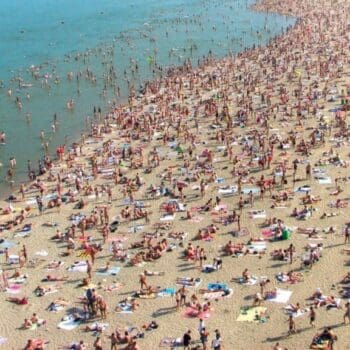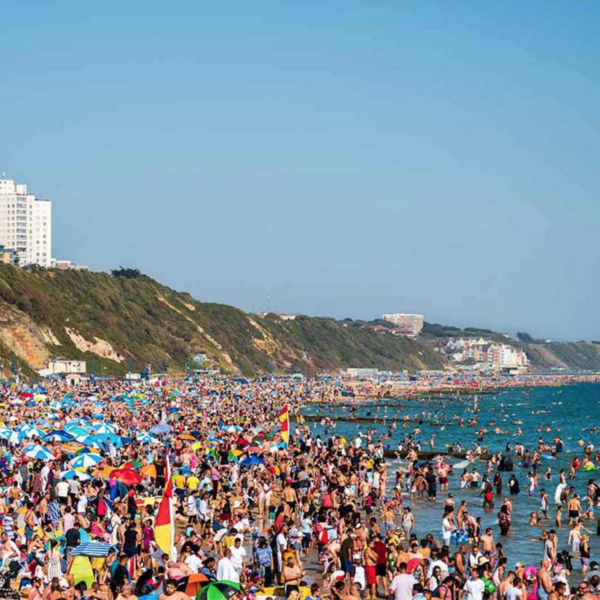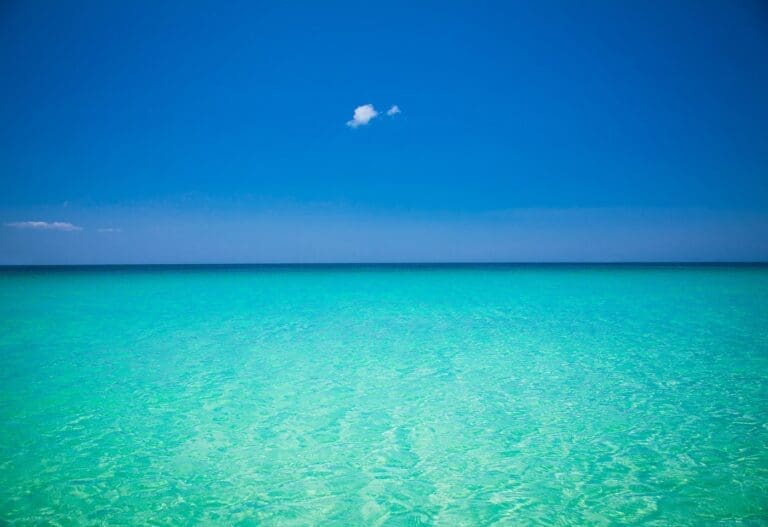 As the summer travel season kicks into high gear, the specter of overtourism looms large over many of the world’s most beloved destinations. In an interview with two EHL researchers and experts on the topic, we explored the multifaceted issue of overtourism and how savvy travelers can avoid the pitfalls of overcrowded hotspots by traveling during shoulder-seasons, staying overnight and discovering destination dupes.
As the summer travel season kicks into high gear, the specter of overtourism looms large over many of the world’s most beloved destinations. In an interview with two EHL researchers and experts on the topic, we explored the multifaceted issue of overtourism and how savvy travelers can avoid the pitfalls of overcrowded hotspots by traveling during shoulder-seasons, staying overnight and discovering destination dupes.
Crowded beaches, congested streets and long queues at tourist attractions – these are all unfortunately familiar sightings when traveling to popular places.
Even though the prices for flight tickets, hotels and trips overall have gone up, the World Tourism Organization UNWTO has forecasted record breaking tourist volumes. Also, 66 percent of travelers said, they’re more interested in travel now than they were before the COVID-19 pandemic, a study by the consulting firm McKinsey showed. With even more people traveling the world the issue of overtourism is exacerbating even more. But how come that so many places seem to be bursting at the seams and are not prepared to handle the masses of tourists?
Overtourism is driven by several key factors. The primary issue lies in the mismatch between increasing travel demand and the limited capacity of popular destinations to accommodate tourists. – Tatyana Tsukanova, EHL- Research Associate
Even a decade ago, many iconic destinations were already struggling with overcrowding. Today, more and more people have the ability to explore the world and through technology it is more accessible than ever.
Not even the increasing inflation and the higher flight ticket prices, have decreased the desire for traveling in a post-pandemic world – Lionel Saul, EHL – Research Assistant
Together, Tsukanova and Saul are working on a strategic foresight project in the hospitality industry, examining current trends, with overtourism emerging as a growing concern.
However, while the demand for travel has surged, many destinations have not adapted their infrastructure to handle the influx. “This leads to immense pressure on local resources, from public transportation to waste management systems, ultimately impacting the quality of life for residents and the experience for visitors”, says Tsukanova. For example, in the Swiss city Lucerne, the city sees a high volume of day tourists who do not stay overnight, causing congestion in the city during the day but without generating the economic benefits that would come with tourists booking longer stays.
Overtourism has become an important reason why people avoid the most popular destinations. Such destinations will still profit from first-time-travelers, but they will also have an issue turning them into returning customers.
A Phocuswright survey about sustainable tourism asked why people avoid a destination. The primary reason was that these places are too crowded. The second most common reason for not visiting a destination is its commercialization. The third reason is that the location is too dirty or poorly maintained.

Travelers express concerns that issues such as climate change and overtourism would affect future vacations. Especially in Spain, a country that has experienced a lot of overcrowded sites and beaches, 61 percent of people say that they are concerned. Also, in France (49%) and Italy (46%) people worry about the growing masses in touristic sites.
Even off the beaten-track destinations go viral
Social media, particularly Instagram and TikTok, play a significant role in driving overtourism. Viral images of picturesque locations like Mount Fuji in Japan or the Trevi Fountain in Rome fuel a desire to visit these places, often without regard for the consequences.
Even lesser known places start to become overcrowded, when social media influencers are geo-tagging new locations that are off the beaten path and do not have a touristic infrastructure per se. This “Instagram-Dilemma” happened in Hallstatt, a small village in Austria with about 800 inhabitant, because it was associated with the Disney Hit-Movie “Frozen”. The village counted around 145,000 overnight stays last year alone, plus hundreds of thousands of day tourists.
While looking for the next new best shot, the social-media-culture inadvertently contributes to the problem by popularizing previously hidden gems, which then become the next victims of overtourism.
Social media not only sets social and cultural expectations but also normalizes the idea of visiting these overexposed sites. “People feel compelled to capture and share their own photos of iconic landmarks, leading to overcrowded conditions that diminish the experience for everyone”, says Tsukanova. “If I travel to Paris, people expect me to send them a picture of me in front of the Eiffel Tower.” The culture of “If you did not take a photo, did it even happen?” is no longer a phenomenon of Gen Y and Gen Z, but has permeated all age groups. This also shows a recent study from McKinsey: 34% of all travelers turn to friends and family via social media when seeking inspiration during the travel planning process.

Toolkit on how to avoid crowded touristic sites
While overtourism is difficult to avoid and reduce, here are few tips for savvy travelers to reduce negative impacts and poor experiences caused by overtourism:
Stay overnight and avoid day-tourists
Some of the worst experiences due to overtourism center around destinations that are exposed to an influx from various transportation modes – in the peak season and at any given day of the week. These are places that can be accesses with buses, cars, planes and cruise ships and there are no limitations and regulations surrounding the touristic influx, such as the popular destinations Dubrovnik, Venice or Mykonos. This can very much worsen the experience for both tourists and residents.
Since crowds mostly disappear after 5 or 6 pm at most of the iconic attractions, staying overnight can be a possible solution on how to avoid the daytime crowds. Also, early birds are often rewarded with uncrowded and unobstructed views of key attractions and can take their pictures before the first tourist groups arrive.
For example in Lucerne, visitors can enjoy the serene beauty of Lake Lucerne and the charm of the Old Town during the quieter evening and early morning hours, exploring iconic sites such as the Chapel Bridge and Lion Monument without the daytime rush.
Or Sintra, a picturesque UN-World heritage site a bit north of Lisbon, is renowned for its stunning palaces, lush gardens, and rich history, attracting a significant number of day tourists. These visitors often flock to Sintra’s main attractions, such as the Palácio da Pena and Quinta da Regaleira, during peak hours, leading to crowded conditions and long lines. The influx of day tourists can make it challenging to fully appreciate the town’s beauty and tranquility. However, for those who stay overnight, Sintra reveals a different side, offering quieter evenings and mornings to explore its enchanting sites without the bustling crowds, allowing for a more immersive and leisurely experience.
Instead of opting for a day-trip and by staying overnight travelers can immerse themselves more deeply in the local culture and atmosphere, enjoying a more relaxed and intimate experience. All in all, this more evenly distributes touristic crowds over the span of the day and the touristic site.
Travel during shoulder seasons
An analysis by McKinsey shows that shoulder-seasons are also becoming more popular for non urban leisure destinations. This goes mainly for Mediterranean Sun & Beach destinations, due to reasons such as the avoidance of crowds, extreme heat and peak prices in the high season.
Such destinations are not only booked during peak travel times but also in between peak and off-seasons. This can be seen in the Spanish regions of Catalonia and the Balearic Islands, for example. Between 2016 and 2023, the relative share of tourist arrivals during shoulder season months of April, May, September and October increased by 2,2% and 3,0% respectively in the Balearic Islands.
This trend is even more pronounced in Greece. The share of shoulder season rose by 6,3% in Rhodes, 5,0% in Crete and 2,9% in Thessaloniki compared to 2019 and 2023.
This trend underscores the growing appeal of off-peak travel times, providing opportunities for destinations to manage tourist flow more effectively and enhance visitor experiences year-round.
Consider less crowded destination dupes
To further avoid overtourism, travelers are increasingly turning to destination dupes—lesser-known locations that offer similar experiences to their more famous counterparts.
Instead of visiting overcrowded beaches in Spain, Italy or France, tourists might explore a quieter beach destination somewhere in Morocco, Montenegro, Portugal or Albania”, Tsukanova suggests.

Phocuswright data suggests that choosing quiet and off-the-beaten-path destinations has become increasingly important when selecting a place to spend the holidays. Whereas beauty is still the most important factor, an uncrowded or off the beaten path destination is gaining momentum.
With the rise of niche-tourism where people go off the beaten track to avoid overtourism, new touristic destinations are on the horizon. For instance, instead of battling the crowds in Venice, travelers can explore the canals and half-timbered houses of Colmar, France. Instead of Mykonos or Santorini, sunbathers could travel to the Cyclades. Those seeking the cultural vibrancy of Barcelona might find a delightful surprise in Valencia, Spain, which offers stunning architecture and nice beaches without the overwhelming tourist influx.
Data shows that Valencia is on the rise and has already outgrown its main competitors in Spain, such as the Canary Islands, the Balearic Islands, Madrid, Andalusia and Catalonia. Compared to 2019, the region of Valencia has welcomed 9,8% more tourists in 2023. As mentioned before, especially the shoulder-season from January to April has become very popular for tourists traveling to Valencia and has seen an increase of 29,4% compared from 2019 to 2024.
“Of course another issue is, if the destination gets popular, that it could get crowded again sooner or later. However, overtourism will only become an issue for such destinations if they do not do enough to manage the resulting increase in the number of accommodations or develop touristic infrastructures to deal with the influx of tourists”, says Saul.
For the time being, such destination dupes and shoulder-season holidays can not only provide a more relaxed and authentic travel experience but also help distribute tourist traffic more evenly and reduce pressure on local communities, both experts agree.
After all, traveling is all about experiences and not just waiting in line to take a quick selfie or catch a small glimpse of an iconic site.



















